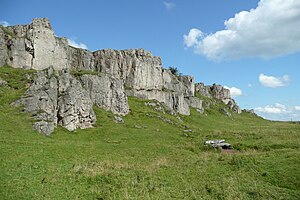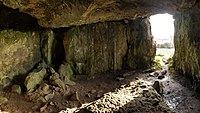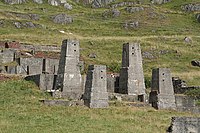Harboro' Rocks
| Harboro' Rocks | |||
| Derbyshire | |||
|---|---|---|---|
 Harboro' Rocks from the High Peak Trail | |||
| Range: | Peak District | ||
| Summit: | 1,243 feet SK243553 53°5’33"N, 1°39’11"W | ||
Harboro' Rocks (or Harborough Rocks) is a hill in the Derbyshire Peak District, near the village of Brassington. The summit reaches 1,243 feet above sea level, with views across to Carsington Water.
The hill is of dolomitic limestone, typical of the White Peak.
Harboro' Cave
- Main article: Harboro' Cave

Within the hill is Harboro' Cave, a natural cavern in the rocks. Archaeologists have found in the cave evidence of human occupants since the Ice Age, but occupation extended even into the modern era: Daniel Defoe reported in his book Tour thro' the whole Island of Great Britain (published in 1726) that a poor family of seven was living in the cave. Defoe described how the father was a lead miner and was "lean as a skeleton, pale as a dead corps" but that they "seemed to live very pleasantly".[1][2]
The cave is today a protected Scheduled Monument.[3] There is a settlement site and chambered cairns nearby.
Mining

The Golconda lead mine, on the north east side of the hill, was part of the Gell family's Griffe Grange mining liberty, which ran from the summit of Harboro' Rocks to the old Roman road, the Via Gellia. The mine dates back to the 1700s and the mine shaft is over 350 feet deep. (The name 'Golconda' was borrowed to suggest a wealthy mine, after the famous Indian Golconda diamond mine.) The mine's tunnels enter natural caverns such as the Great Shack. After closing in 1913, the mine was reopened in 1915 to mine baryte until 1953.
Furnace-lining bricks have been manufactured from local quartz sand at Harborough brickworks for many years (recently by Hobens Minerals and previously by Swan Ratcliffe).[4][5]
Rocks
Most of the White Peak is a carboniferous limestone plateau. The Haraboro' Rocks are an unusual jagged outcrop of dolomitic limestone which offers interesting buttresses, arêtes and pinnacles for rock climbing (and some easy bouldering) with over 100 graded routes.[6]
Nearby Rainster Rocks is another dolomitic limestone crag and is the site of a Romano-British settlement and field system from the 3rd century. The remains include enclosures with walls made of upright boulders (orthostats) and earthwork terraces. Excavations have found pottery fragments, metalwork and coins. The site is a listed ancient Scheduled Monument.[7] Rainster Rocks was also a popular rock climbing location (with over 80 graded routes) and has been climbed for over 100 years. However the landowners have imposed an outright ban on climbing there since 2018.[8]
Walking
The land around Harboro' Rocks is designated as "Open Access" land for the public.
The High Peak Trail and the Midshires Way footpaths follow the same route along the south west side of the hill. The Limestone Way long-distance footpath passes the north west side of the hill.
References
- ↑ 'When Robinson Crusoe Visited Brassington': Brassington Community
- ↑ Slack, Ronald (2000). "Lead Miners' Heydey". https://pdmhs.co.uk/docs/slack---lead-miners-heyday.pdf.
- ↑ National Heritage List 1007044: Harboro' Cave (Scheduled ancient monument entry)
- ↑ Ford, Trevor; Jones, John (2007). "The Geological Setting of the Mineral Deposits at Brassington and Carsington, Derbyshire". https://pdmhs.co.uk/MiningHistory/Bulletin%2016-5%20-%20Geological%20Setting%20of%20the%20Mineral%20Deposits%20at%20Brassington%20and%20Carsington.pdf.
- ↑ Jones, John (2010). "The Golconda Mine Orebody". http://www.emgs.org.uk/files/mercian_vol13on/Mercian%20Geologist%20volume%2017%202008-2011/Mercian%202010%20v17%20p205%20Golconda%20minerals,%20Jones.pdf.
- ↑ "Harborough Rocks" (in en). http://www.ukclimbing.com/logbook/crag.php?id=111.
- ↑ National Heritage List 1018475: Romano-British settlement and field system at Rainster Rocks (Historic England)
- ↑ "Brassington (Rainster Rocks)" (in en). http://www.ukclimbing.com/logbook/crag.php?id=112.